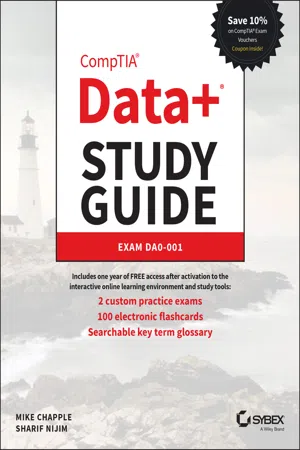
CompTIA Data+ Study Guide
Exam DA0-001
Mike Chapple,Sharif Nijim
- English
- ePUB (handyfreundlich)
- Über iOS und Android verfügbar
CompTIA Data+ Study Guide
Exam DA0-001
Mike Chapple,Sharif Nijim
Über dieses Buch
Build a solid foundation in data analysis skills and pursue a coveted Data+ certification with this intuitive study guide
CompTIA Data+ Study Guide: Exam DA0-001 delivers easily accessible and actionable instruction for achieving data analysis competencies required for the job and on the CompTIA Data+ certification exam. You'll learn to collect, analyze, and report on various types of commonly used data, transforming raw data into usable information for stakeholders and decision makers.
With comprehensive coverage of data concepts and environments, data mining, data analysis, visualization, and data governance, quality, and controls, this Study Guide offers:
- All the information necessary to succeed on the exam for a widely accepted, entry-level credential that unlocks lucrative new data analytics and data science career opportunities
- 100% coverage of objectives for the NEW CompTIA Data+ exam
- Access to the Sybex online learning resources, with review questions, full-length practice exam, hundreds of electronic flashcards, and a glossary of key terms
Ideal for anyone seeking a new career in data analysis, to improve their current data science skills, or hoping to achieve the coveted CompTIA Data+ certification credential, CompTIA Data+ Study Guide: Exam DA0-001 provides an invaluable head start tobeginningor accelerating a career as an in-demand data analyst.
Häufig gestellte Fragen
Information
Chapter 1
Today's Data Analyst
Welcome to the World of Analytics
Data

Storage
| Year | Cost per GB |
|---|---|
| 1985 | $169,900 |
| 1990 | $53,940 |
| 1995 | $799 |
| 2000 | $17.50 |
| 2005 | $0.62 |
| 2010 | $0.19 |
| 2015 | $0.03 |
| 2020 | $0.01 |
Computing Power
Inhaltsverzeichnis
- Cover
- Table of Contents
- Title Page
- Copyright
- Dedication
- Acknowledgments
- About the Authors
- About the Technical Editor
- Introduction
- Chapter 1: Today's Data Analyst
- Chapter 2: Understanding Data
- Chapter 3: Databases and Data Acquisition
- Chapter 4: Data Quality
- Chapter 5: Data Analysis and Statistics
- Chapter 6: Data Analytics Tools
- Chapter 7: Data Visualization with Reports and Dashboards
- Chapter 8: Data Governance
- Appendix: Answers to the Review Questions
- Index
- End User License Agreement